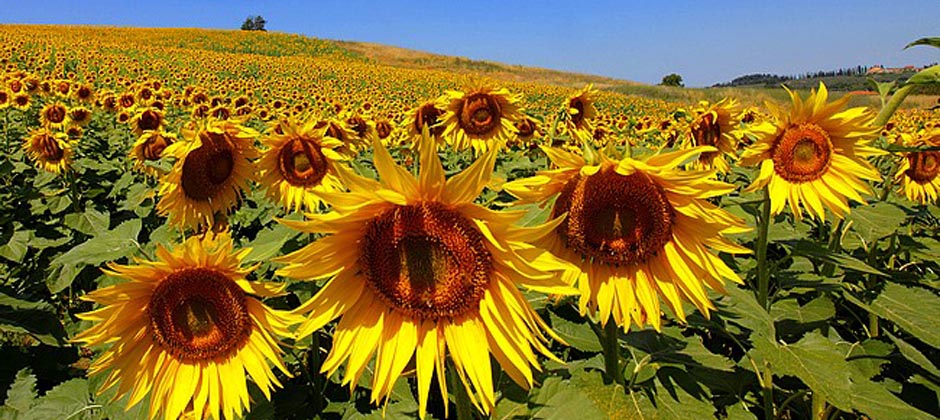Our Land, The Chiana Valley

«"Fields of such beauty are impossible to find elsewhere; every lump of earth has been tilled to perfection, prepared for sowing. Wheat grows lushly on this soil, where it seems to find all the necessary conditions to thrive. Every other year they plant horsebean, because oat does not flourish here. They also plant lupines, now already green, which will ripen by the month of March. Flax too, is already sown; buried into the ground throughout the winter, it is toughened by the freezing cold. »
Johann Wolfgang von Goethe,
Italian Journey
The Chiana Valley (Val di Chiana or Valdichiana) is one of the most humanized landscapes of Italy. Originally the area stretched over approximately 90 kilometers, bounded at both ends by two cities, Arezzo to the north and Orvieto to the south. This valley became a flourishing home to the Etruscan populations living in four of the twelve city-states of the ancient Etruscan League: Arezzo (Arretium), Cortona (Cortonae), Chiusi (Clusium) and Orvieto (Urbe-Vetus). Due to the high yields and quality crops from its plain and gently rolling hills, Valdichiana has been famed as the "granary of Etruria" since the time of earliest civilizations. In 476 BC, the fall of the Western Roman Empire ushered in the period of invasions by barbarian tribes of Northern Europe, followed by the Lombards (or Longobards) and then by Charlemagne. A little over fifty years following the barbarian conquest, Valdichiana gradually became a marshy area and the once fertile plains turned into wetlands, including the territories surrounding Arezzo and Siena: Fabro, Monteleone, Città della Pieve, Cetona, Chiusi, Castiglione del Lago, Montepulciano, Torrita, Sinalunga, Cortona, Foiano, Lucignano, Monte San Savino, Castiglion Fiorentino, Civitella and Arezzo itself. The waterlogging phenomenon, known as paludification, reached such proportions that Dante Alighieri referred to it multiple times in his "Divine Comedy", as did other poets of the time. The inhabitants living at the bottom of the valley therefore started a massive migration that led them to settle on the higher hills, giving birth to the above-mentioned walled towns that we know today, jewels of medieval fortified architecture nestled in the smoothly rolling hilltops of Valdichiana. In 1338, after yielding to Florentine domination, Arezzo was ordered by the city of Florence to cut the hill of Chiani. The first section of the "fossatum novum" (new ditch) was built by literally hacking down about 400 meters of Tuscan rock; this channel allowed the stagnant waters of the San Zeno plain to reverse their course, running into the Arno river near the Buriano Bridge. That marked the beginning of the water reversal phenomenon known all over the world as the "reversal of the Chiana river". In the newly reclaimed land totaling about 7,000 hectares, acquired by the Florentine House of Medici before coming, between 1737 and 1859, under the rule of the House of Lorraine, twelve "grand-ducal farms" were built (Dolciano, Acquaviva, Abbadia, Bettolle, Foiano, Pozzo, Fontarronco, Bastardo, Frassineto, Montecchio, Creti, Chianacce) along with 260 homesteads called "Leopoldine", with their distinctive architectural style and typical pigeon tower at the center. Towards the end of the 18th century, the valley resumed its leading position in the production of arable crops and in livestock farming, particularly the "Chianina" breed of cattle, reaching a peak of excellence in the production of silk yarns. In 1770, the Grand Duke Peter Leopold of Lorraine reopened a "Silk Route" in Valdichiana, by ordering additional planting of mulberry along the roads of the reclaimed land and the banks of the new water channels, and introducing silkworm rearing in every "Leopoldina" homestead. This event heralded the "rebirth" of the small Etruscan settlements and historic cities, as well as the establishment of new and thriving communities, which are still holding pride of place in our flourishing valley.
Via Casali, 6 52044 Cortona, Italia tel +39 0575 653 125 roggicortona@gmail.com
Via del Marzocco, 5 55045 Pietrasanta, Italia tel +39 0584 332 300 roggipietrasanta@gmail.com
Via Palestro, 2 53037 San Gimignano, Italia tel +39 0577 940 760 roggisangimignano@gmail.com
mob +39 333 6461 405
